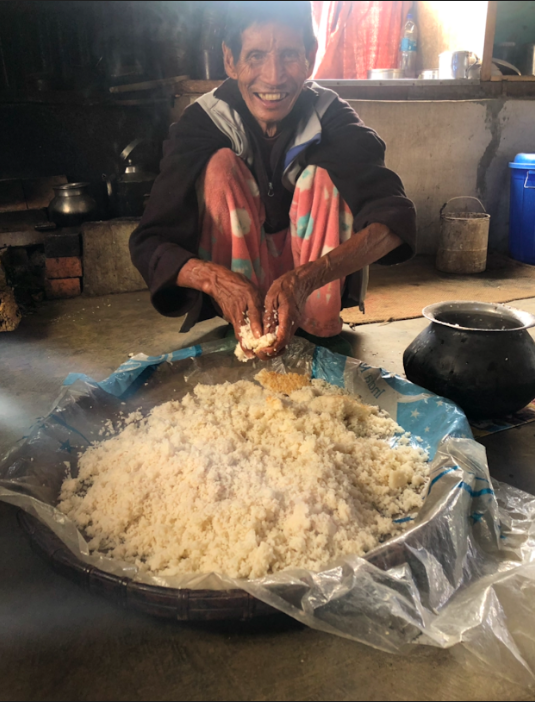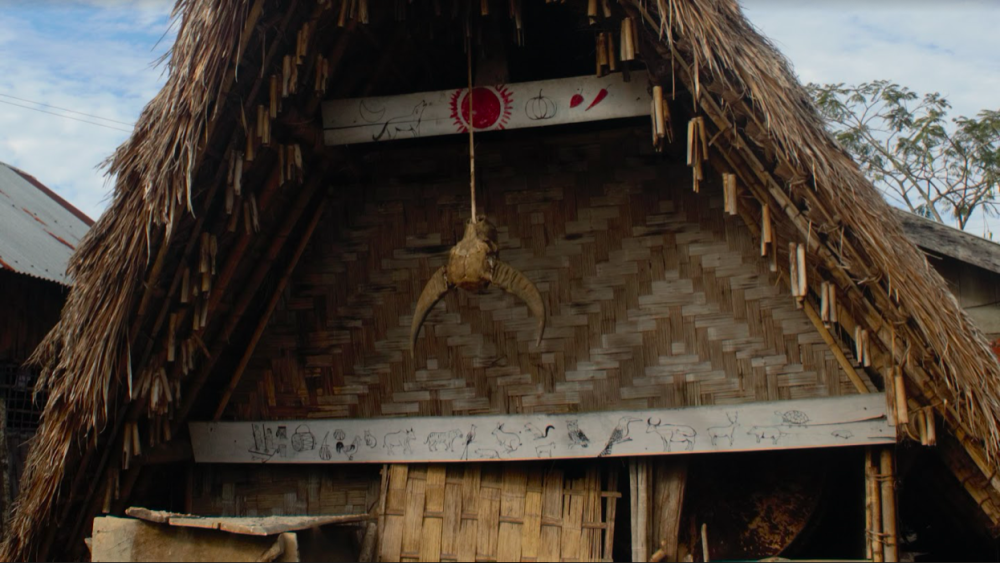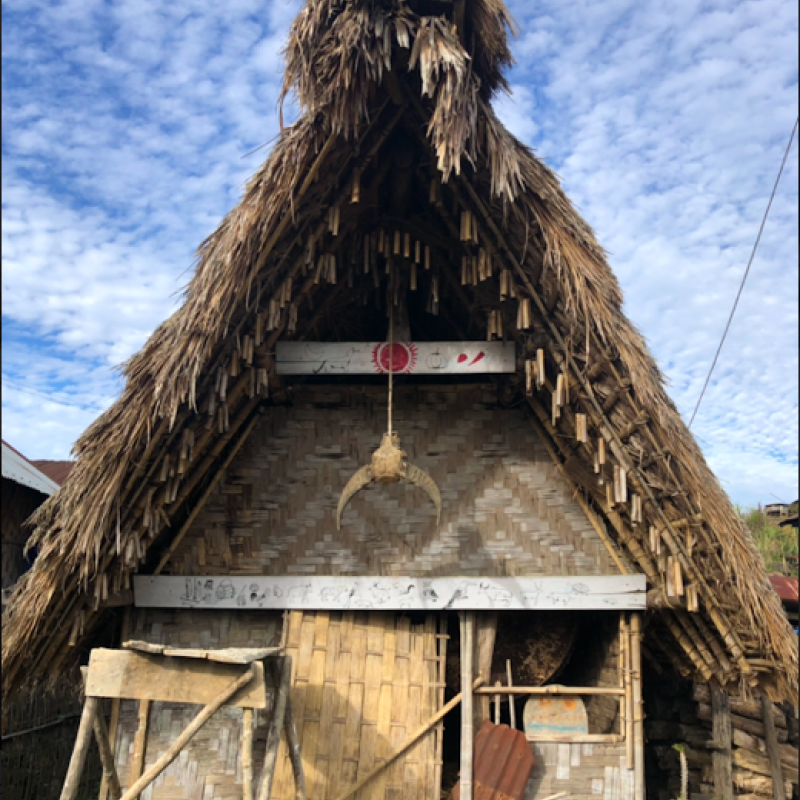The Ruangmei Nagas, like other Naga tribes, are known for their rich cultural heritage. Their traditions are rooted in their origin as part of a conglomerate of tribes called the Zeliangruang, which comprise of the Zemei, the Liangmei, the Ruangmei and Inpui tribes. Zeliangruang Naga people are racially grouped as Tibeto-Burman, both ethnically and linguistically.[1]
The origin of the Zeliangruang people and where they migrated from is still shrouded in mystery, but like the Hmar’s, the Zeliangruangs are also said to have migrated from China’s Sinlung province where they travelled from one place to another until they finally settled in Makuilongdi in present-day Manipur. The Ruangmeis were part of the Zeliangrong tribe that stayed in Makuilongdi where they lived together for a very long time until the village expanded and many people departed in search of greener pastures. There are different opinions and views on how each of the individual tribes got their names, but the most popular theory remains that it is indicative of directions. It is said that the chief of Makuilongdi had three sons and when the village became overpopulated, two of the sons moved out to different directions with their flock. Those who remained in Makuilongdi named those who went to the south Maruangmei (people from the south) which over time became Rongmei/Ruangmei.[2]
The Ruangmei people are currently mostly situated in the Tamenglong and Noney districts of Manipur and in the neighbouring states of Assam and Nagaland. Before the advent of Christianity, the Ruangmei people were said to be pantheists.
Tradition of Ruangmei Folk Music
It is often said that if one is interested in learning about the life and culture of a group of people, they should study their songs, which are a rich source of the sociocultural history of the people who wrote it. Folk songs often cover a wide area of human life, sociocultural activity and social issues in verse and poem that emanate from the cultural dynamics involving gender, economy, politics, religion, philosophies, and so on.
The Ruangmeis, similarly, have a rich tradition of folk songs and music where song and dance take place in very intimate moments of their lives. Their folk songs illuminate the daily and cultural lives, and shed light on their philosophical inclinations. These folk songs allow the Ruangmeis to preserve the memories and traditions of their culture, and to pass them on to the future generations. The folk songs cover various events and themes like war, agricultural seasons, festivals, love, romance, places of origin, as well as the Ruangmei history, rites, rituals, social mores, customs, ways of living, and so on.
These folk songs were orally transmitted through the Ruangmei dormitory system, the locus of Ruangmei tribal culture, education and participation. Men and women had separate dormitories, named khangchiu and liuchiu, respectively. Young men and women attended these dormitories and were educated in the various art forms, roles and ways of the tribe. The dormitories played an important role in the preservation of the folk arts, songs and music through oral transmission. They were important sociocultural and educational institutions of the Ruangmei community and helped in the functioning of the village by disseminating knowledge and ensuring the participation of the youth. Songs were taught in the dormitories and passed on to the young men and women by Ruangmei elders. Men learnt how to play and make musical instruments like nrah (cup violin), nkhuangh (drum), alim (flute), syanmw (gong) and siamtuaic (cymbals).
The folk songs of the Ruangmeis varied from occasion to occasion, and the ngais (festivals) mostly centred around agricultural activities and were celebrated almost every month of the year in tune with the changing cycles or seasons of the agricultural year. Songs were sung during the ngais accompanied by musical instruments at processions. Most of these ngais are not celebrated anymore except for the Chakaan Gaan ngai (post-harvest winter festival).
Songs sung during ngais
Guhdui ngai: Guhdui ngai literally translates to ginger soup festival. It was celebrated towards the end of April or the beginning of May, after completing the task of seed sowing in the field where the farmers sang the lau phun lu (seed sowing song) and lau ruaih lu (field cultivation song)[3] as they tended to the fields. The songs were sung during work to appease the gods of the harvest. It was believed that if the farmers worked in a happy and joyful mood, they were blessed with a good harvest. During Guhdui ngai, people drank ginger and chicken soup with the belief that it promotes good health and long life; back in the day, Ruangmeis considered ginger and chicken soup to bring prosperity and provide protection from famine and hunger.
Pukpha ngai: Pukpha ngai was a pre-harvest festival celebrated in the month of Pukpha bw (August). The main theme of the ngai was thanksgiving, where the head priest would pray for abundant harvest. During Pukpha ngai, people in Ruangmei villages collectively chanted, sang kailaam (pre-harvest) lu and offered prayers to the deities for the development of the place.
Khaam ngai: Khaam ngai was celebrated at the start of the crop harvest with nrah lu. During this festival, members of the different dormitories in a village cleared the paths to the fields to be harvested. The dormitory members chosen at birth who had attained puberty were officially inducted into their respective dormitories during the Khaam ngai. Membership to the dormitories were given during this festival although members were already chosen at birth.
Chakaan Gaan ngai: Gaan ngai is a post-harvest ngai and is the biggest ngai celebrated by the Ruangmeis. Though the time of the celebration differs from place to place, traditionally Gaan ngai is celebrated in October–November. The festival goes on for a duration of five to seven days depending on the region and its people. Each day has a particular theme and its accompanying events. Gaan ngai involves feasts and games as well as dancing and singing, including mazah lu (rice/ paddy song) and zouh sou lu (song of wine making that people sing while making rice wine).
The kairong ron lu (guard song) is also sung by the youth and warriors of the tribe in the Gaan ngai to provide a sense of security to the members of the village and the tribe.

Chago ngai: Chago ngai was celebrated in the month of January/February. It was exclusively celebrated by the men of the village and was a celebration of bravery and warriors. Rih lu and chago lu (songs of war and bravery) were sung during this festival.
The songs sung at the ngais were closely entwined with the agricultural lives of the Ruangmei people who were mostly into farming.
Besides ngais and the rites and rituals that took places at the events there is one main ritual celebration in Ruangmei and Naga culture known as the baanruh (feast of merit). In Ruangmei culture, it is the social responsibility of the wealthiest person in the village to host a feast for the entire village and erect a taraengvkai (traditional ceremonial house) after the conclusion of the feast. (Fig. 2) Songs like baanruh lu (feast of merit song) and matui lu (song of the dormitories) were sung at the baanruh by the members of the dormitories and the village.

In the baanruh, the host provides everything from food, drinks, gifts, etc., and the members of the village and dormitories help in cooking, building taraengvkai, singing, dancing, and other work related to the event. Baanruh is important in many ways; it puts the need of the village above individual needs and binds the tribe into a unit. As the host spends much of his money on the feast, baanruh helps maintain economic parity among the Ruangmeis. In return, the baanruh host earns the respect of the village which erects the taraengvkai in his honour.
Songs on folk heroes
Ruangmei culture is rich with songs of love, romance and regrets sung by men who became important figures in society. These songs later got categorised into genres such as lamluan lu (songs of love) and majian lu (lamentation song) and became entrenched in the history Ruangmei folk music. Singers of lamluan lu and majian lu such as Keiguinang, Kariukiu and Hognionang[4] were wildly popular with the Ruangmei people.
One such popular song is on the folk legend of Gariamnang (known as an ideal lover among the Ruangmei people). The song, known as Gairiamnang lu, was composed for the beloved Guirianei by a heartbroken Gariamnang. The song details the story of how the two grew up to love each other despite all odds. Gairiamnang lu’s story progresses as the hero leaves in search of the perfect place for the lovers. However, time passes by and there is with no sign of Gariamnang’s return and, as fate would have it, Guirianei is married to another man. When Gariamnang finally comes back to the village and hears the news, he is heartbroken and composes the song for her.
Then there were songs of other folk heroes of the Ruangmei people which did not fall into either category of lamentation or love. For example, there is an interesting story that seems to foreshadow the dawn of Christianity among the Ruangmeis; it is the story of Amangh (a visioner who built the first traditional house) who had a premonition and predicted the birth of a baby named Emmanuel through a song. He narrated that a child of love will be born, and he will be the best gift from heaven. The song related to this even as known as amangh (prediction) lu among the Ruangmei people; to this day, it is not clear how the name Emanuel figured in pre-Christian Ruangmei society.[5]
As with most cultures, Ruangmei people also have nah lus (children’s songs and lullabies) which are rhymes that inculcate morals in children from a young age.[6] Among the more contemporary Ruangmei folk songs are Jadonang lu, named after a truly important figure in Ruangmei as well as Zeliangruang culture. Haipou Jadonang was a visionary, a spiritual leader, who is said to be directed and instructed by God on the ways towards the salvation of his people. Haipou Jadonang established the socioreligious Heraka movement that established the Heraka religion, said to be an amalgamation of Christian monotheism and Hindu temple worship; he was a thorn for the British Raj and a boon for Naga unity. Thus, Jadonang lu are songs dedicated to Haipou Jadonang and is a category in its own right.
To this day, song and dance are an important aspect in the now Christian Ruangmei community where during Christmas singing and dancing accompanied by drum beats go on for days. Traditionally, the Ruangmei people sang songs specific to festivals and rituals associated with the agricultural cycle of Manipur. They sang songs for almost every occasion: while working, sowing, weeding, pounding rice, harvesting, during festivals, rituals and ceremonies, love and grief, and so on. Songs were an inseparable part of Ruangmei lives and provide a lens to their past, a worldview that is slowly dissipating due to lack of documentation.
Ruangmei folk art is in its death throes. Among its various challenges are the advent of Christianity and modernity and the fact that its last generation of performers are now very old. The Ruangmei elders learnt the songs from their forefathers who lived a pre-evangelist village community life, but the younger generation’s continued lack of interest in the traditional forms of art coupled with their distraction and investment in Western ideals and culture has blocked way for a natural oral transmission of cultural knowledge. Further, traditional practices are seen by the newly reformed Christian members of the tribe as ungodly and discouraged. With lack of conscious intervention, we might be staring at a future where Ruangmei cultural practices with their songs and stories will be entirely washed away from the face of the earth.
*This project follows the new orthography developed by the Ruangmei Literature Society and follows the RLS dictionary
Notes
[1] Kamei, The History of Zeliangrong Nagas, 15–16.
[2] Pamei, The Trail of Makuilongdi, 14–15.
[3] Soundcloud.com. ‘Lau Ruaih Lu (Ramrisuang Pamei).’
[4] Soundcloud.com. ‘Hongianang Lu (Namthiubiubou).’
[5] Pamei, The Trail of Makuilongdi, 30–31.
[6] Soundcloud.com. ‘Na Lu(Lungkiang Giang).’
Bibliography:
Kamei, Gangmumei. The History of Zeliangrong Nagas: From Makhel to Rani Gaidinliu. Guwahati: Spectrum Publications, 2004.
Mishra, R. and K. Newme. ‘Social Communication and Traditional Folk Media of the Zeme Naga Society.’ Global Media Journal: Indian Edition 6 (2015): 1–15.
Pamei, Namthiubuyang. The Trail from Makuilongdi: The Continuing Saga of the Zeliangrong People. Tamenglong: Gironta Charitable Foundation, 2001.
Perks, Robert, and Alistair Thomson, eds. The Oral History Reader. 3rd ed. London, England: Routledge, 2015.
Rice, Timothy. Ethnomusicology: A Very Short Introduction: A Very Short Introduction. New York, NY: Oxford University Press, 2013.
Soundcloud.com. ‘Lau Ruaih Lu (Ramrisuang Pamei).’ Accessed October 5, 2020. https://soundcloud.com/user-863073039/lau-ruaih-lu-ramrisuang-pamei/s-MwVVSBMU9AM.
Soundcloud.com. ‘Hongianang Lu (Namthiubiubou).’ Accessed October 5, 2020. https://soundcloud.com/user-863073039/hongianang-lu-namthiubiubou/s-Cx9UQekeqmh.
Soundcloud.com. ‘Na Lu(Lungkiang Giang).’ Accessed October 5, 2020. https://soundcloud.com/user-863073039/no-8-na-lulungkiang-giang/s-IJAdb0GIb6y.

